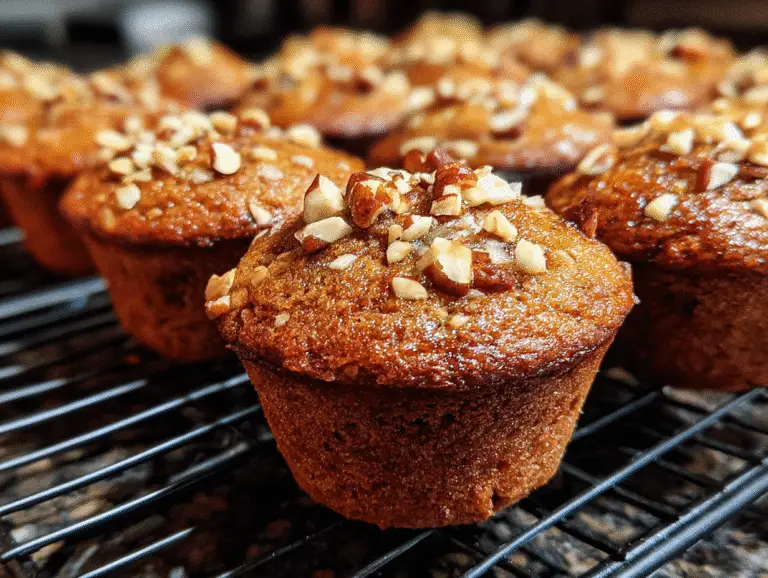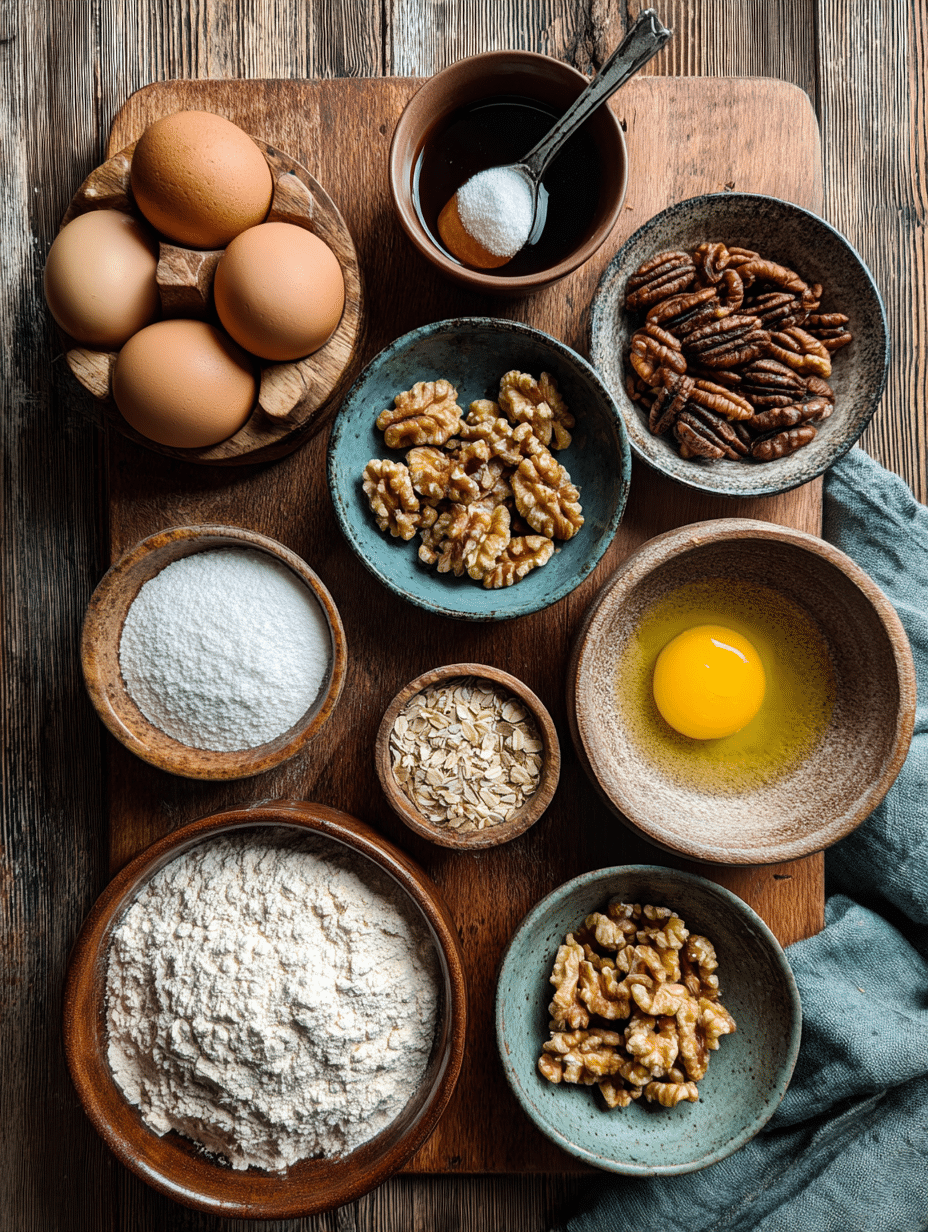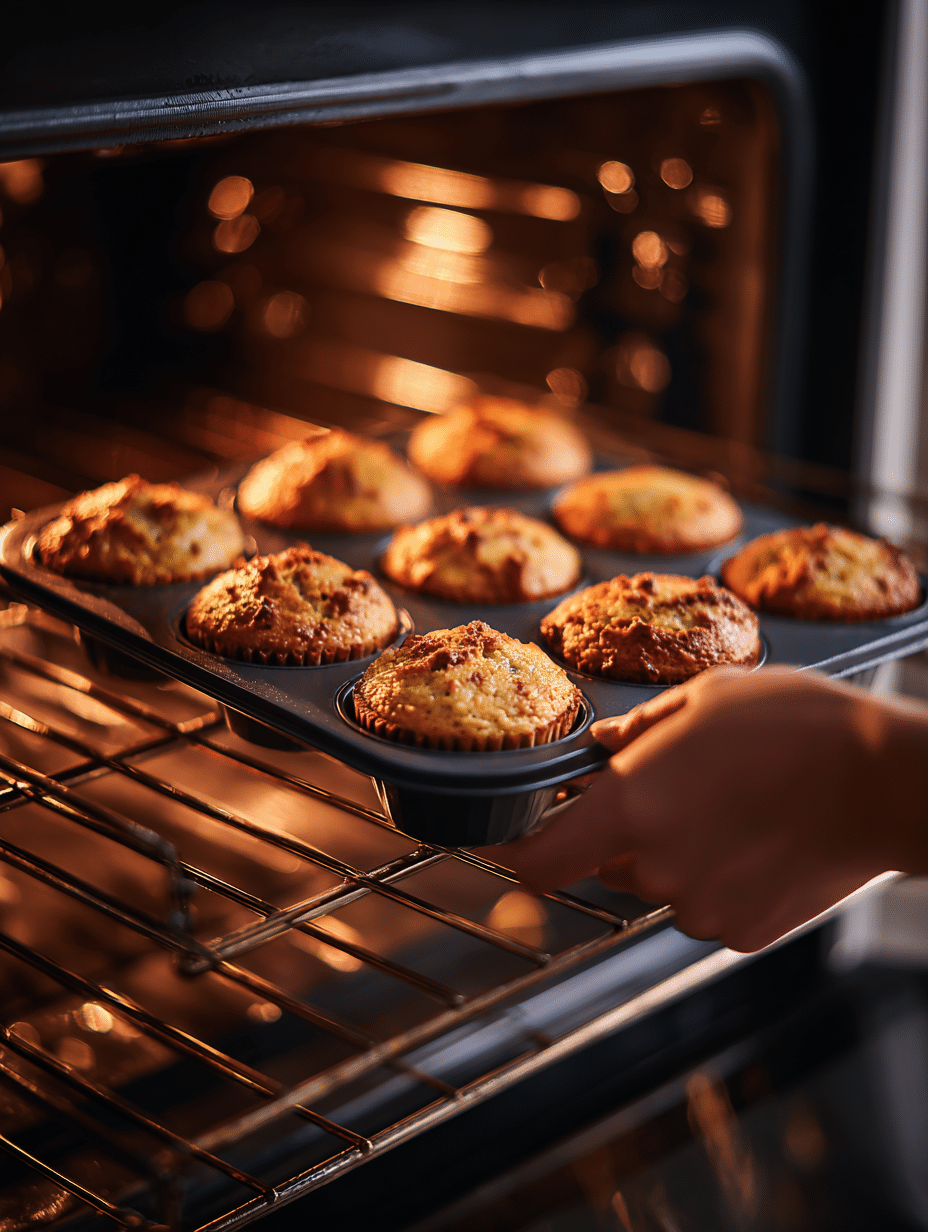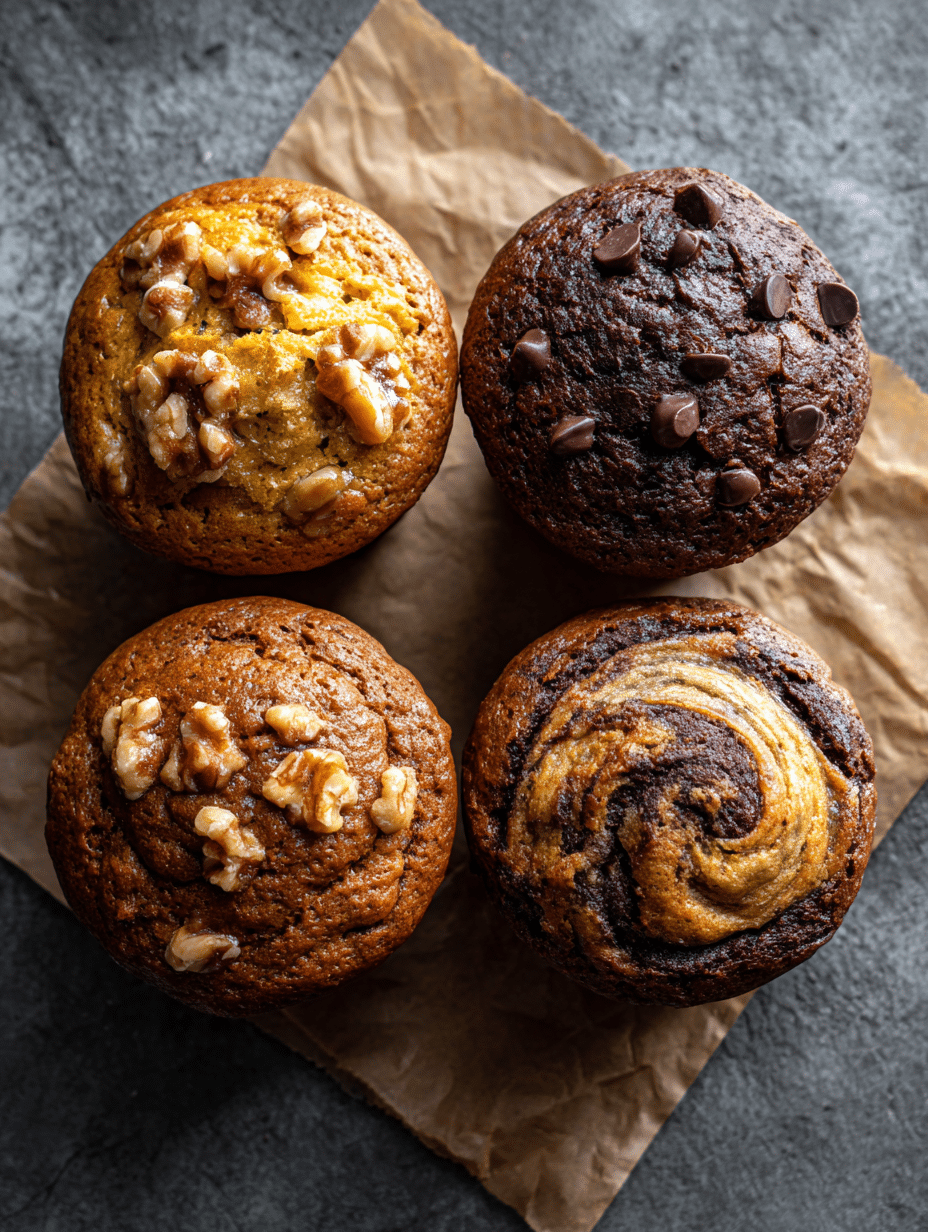If you’re craving a bakery-style treat that fits your gluten-free lifestyle, you’re going to love these gluten free banana nut bread muffins. Soft, naturally sweet, and filled with crunchy nuts and ripe banana flavor, these muffins are a go-to for breakfast, snacks, or even dessert—without the wheat.
More and more people are baking gluten-free at home, but many struggle to make muffins that are actually moist and fluffy. That’s where these gluten free banana nut bread muffins stand out. This guide goes beyond just a recipe—we’ll cover the best flour combinations, the top mistakes to avoid, and how to make your muffins dairy-free, vegan, or low-sugar.
You’ll also learn how to get that perfect bakery-style rise, how to freeze these gluten free banana nut bread muffins for meal prep, and which nuts and sweeteners add the most flavor without overwhelming the banana base.
Don’t miss our chocolate chip banana bread—a classic recipe you can easily adapt into muffins using gluten-free flours.
Table of Contents

Gluten Free Banana Nut Bread Muffins – Moist, Healthy, and Easy to Bake
Soft, moist gluten‑free banana nut muffins made with almond and oat flour, ripe bananas, and crunchy nuts—perfect for breakfast, snacks, or dessert without the wheat.
- Total Time: PT35M
- Yield: 12 muffins 1x
Ingredients
- 3 medium overripe bananas (mashed, ~1¼ cups)
- 2 eggs (or flax eggs)
- 1 cup almond flour
- ¾ cup gluten‑free oat flour
- 2 tbsp tapioca starch
- 1½ tsp baking powder
- ½ tsp baking soda
- 1 tsp cinnamon
- ¼ tsp salt
- ⅓ cup olive oil or coconut oil
- ¼ cup maple syrup or honey
- 1 tsp vanilla extract
- ½ cup chopped walnuts or pecans (plus extra for topping)
Instructions
- Preheat oven to 350 °F (175 °C). Line a 12‑cup muffin tin.
- Mash bananas. In a large bowl, whisk bananas, eggs (or flax eggs), oil, maple syrup (or honey), and vanilla.
- In another bowl, combine almond flour, oat flour, tapioca starch, baking powder, baking soda, cinnamon, and salt.
- Stir dry ingredients into wet until just mixed.
- Fold in nuts. Scoop batter into muffin cups (~¾ full), top with extra nuts.
- Bake 18–22 minutes until a toothpick comes out clean. Cool in pan 5 min, then transfer to rack.
Notes
Use overripe bananas for natural sweetness. Don’t overmix batter—fold gently. Store airtight: room temp 3 days, fridge 1 week, freezer 3 months.
- Prep Time: PT15M
- Cook Time: PT20M
- Category: Breakfast
- Method: Baking
- Cuisine: Gluten‑Free
- Diet: Vegetarian
Nutrition
- Serving Size: 1 muffin
- Calories: 200
- Sugar: 8g
- Sodium: 100mg
- Fat: 12g
- Saturated Fat: 3g
- Unsaturated Fat: 7g
- Trans Fat: 0g
- Carbohydrates: 22g
- Fiber: 3g
- Protein: 5g
- Cholesterol: 20mg
What Are Gluten Free Banana Nut Bread Muffins?
Defining Gluten Free Banana Nut Bread Muffins
Gluten free banana nut bread muffins are a healthier, wheat-free twist on a classic comfort food. They combine the moist texture and sweet flavor of banana bread with the bite-sized convenience of muffins—all made without any gluten-containing ingredients. These muffins are usually baked with gluten-free flours like almond, oat, or rice flour and often include chopped walnuts or pecans for added crunch and nutrition.
What sets them apart is their dense but soft crumb, rich banana flavor, and naturally sweet profile. Unlike many store-bought gluten-free baked goods that taste dry or artificial, well-made banana nut muffins are moist, fluffy, and perfectly balanced in flavor and texture.
Who Should Eat Gluten-Free Baked Goods?
Anyone with celiac disease, non-celiac gluten sensitivity, or wheat allergies should avoid gluten. But many people now choose gluten free banana nut bread muffins for lifestyle reasons—whether they’re following a low-inflammation diet, trying to reduce bloating, or simply experimenting with alternative flours.
These muffins are also great for:
- Kids’ lunchboxes
- Healthy grab-and-go breakfasts
- Midday snacks without the sugar crash
- Athletes or fitness lovers looking for fuel that’s gluten-free
Even if you’re not strictly gluten-free, baking without wheat opens the door to nutrient-dense flours that are high in fiber, protein, or healthy fats.
Health Benefits of Combining Banana, Nuts, and Gluten-Free Ingredients
Let’s break down what makes these muffins a smart snack:
| Ingredient | Health Benefit |
|---|---|
| Bananas | Natural sweetness, potassium, fiber |
| Walnuts/Pecans | Omega-3s, brain health, healthy fats |
| Almond/Oat Flour | Gluten-free, protein, blood sugar control |
| Eggs or Flax | Protein, structure, and moisture retention |
By choosing high-quality ingredients, gluten free banana nut bread muffins can be just as satisfying as traditional versions—but with added health benefits and fewer allergens.
Check out banana bread with cinnamon crunch—a cozy, gluten-free inspired bake that brings out the best in bananas and nuts.
Key Ingredients for Moist & Fluffy Muffins

Which Flours Work Best in Gluten Free Banana Muffins?
The secret to perfect gluten free banana nut bread muffins starts with the right flour. Not all gluten-free flours behave the same—some add structure, others contribute moisture, and a few do both.
Here are top flours that perform well in muffins:
| Flour Type | Why It Works in Muffins |
|---|---|
| Almond Flour | Moist texture, subtle nuttiness |
| Oat Flour | Mild taste, excellent for banana pairing |
| Brown Rice Flour | Adds bulk and softness |
| Sorghum Flour | Nutrient-dense with good rise |
| Tapioca Starch | Improves elasticity and crumb |
For best results, use a gluten-free flour blend that combines 2–3 of these. This ensures your muffins hold together and stay moist.
Best Nuts to Use: Walnuts vs. Pecans
While both nuts work well, walnuts are the traditional choice in banana bread for their earthy flavor and tender crunch. Pecans, on the other hand, offer a naturally sweet, buttery note.
Use toasted nuts for deeper flavor. Chop them finely to ensure even distribution in each bite.
- Walnuts – Great omega-3 source, bold flavor
- Pecans – Slightly sweeter, softer crunch
You can also mix both for a flavor-packed combination.
Role of Ripe Bananas and Natural Sweeteners
Bananas do more than add flavor—they provide natural moisture and sweetness. For ideal muffins:
- Use overripe bananas with black spots
- Mash until creamy to mix evenly
- The more ripe, the sweeter the muffin (less sugar needed)
Consider sweetening your gluten free banana nut bread muffins with:
- Maple syrup – rich, natural sweetness
- Coconut sugar – lower glycemic index
- Honey – adds moisture and aroma
- Mashed dates – whole food option for fiber + sweetness
Don’t miss our sticky banana bread cinnamon rolls for another use of overripe bananas that turns out gooey, indulgent, and gluten-free adaptable.
Gluten Free Flour Options for Banana Muffins
Which Gluten Free Flour Is Best for Banana Bread?
When baking gluten free banana nut bread muffins, the flour you use can make or break the texture. The goal is a moist, tender crumb that holds its shape—without gluten. The most reliable choices for banana bread-based muffins are:
| Flour | Best Feature |
|---|---|
| Oat Flour | Soft, moist, and mildly sweet |
| Almond Flour | Rich flavor and dense texture |
| Sorghum Flour | Adds fiber and structure |
| Brown Rice Flour | Light and neutral |
Among these, oat flour stands out in gluten free banana nut bread muffins for its natural moisture retention and smooth consistency.
Which Gluten Free Flour Is Best for Muffins?
When you’re working specifically with muffins—not just banana bread—texture and rise become even more important. In gluten free banana nut bread muffins, a flour blend works best.
Here’s how common flours perform:
- Almond Flour – Great moisture and mild nutty flavor
- Sorghum or Millet – Balanced texture
- Tapioca or Potato Starch – Adds stretch
- Coconut Flour – Use in small amounts only
- All-Purpose GF Flour Blends – Beginner-friendly, pre-balanced
If you’re unsure where to start, a store-bought blend is great for your first batch of gluten free banana nut bread muffins.
Using Flour Blends vs. Single-Flour Options
Single flours rarely deliver the structure needed for perfect gluten free banana nut bread muffins. That’s why most recipes—especially those that include bananas and nuts—use blends.
| Single Flour | Limitation |
|---|---|
| Almond Flour | Too dense without starch |
| Coconut Flour | Absorbs too much liquid |
| Rice Flour | Can taste gritty on its own |
Using a balanced blend gives your gluten free banana nut bread muffins the best shot at turning out fluffy, moist, and bakery-worthy.
Learn more about cottage cheese banana bread—a flour-forward recipe you can modify with your favorite gluten-free mix.
Step-by-Step Recipe for Gluten Free Banana Nut Bread Muffins

Required Tools and Ingredients
Before you start baking, gather everything you’ll need for your gluten free banana nut bread muffins. This helps avoid over-mixing or missing critical steps mid-recipe.
Tools:
- Muffin pan (12-cup standard size)
- Mixing bowls (1 large, 1 medium)
- Whisk and silicone spatula
- Ice cream scoop or spoon (for even batter portions)
- Parchment muffin liners or non-stick spray
Ingredients:
| Ingredient | Amount |
|---|---|
| Overripe bananas (mashed) | 3 medium (~1 ¼ cups) |
| Eggs or flax eggs | 2 |
| Almond flour | 1 cup |
| Oat flour (certified GF) | ¾ cup |
| Tapioca starch | 2 tbsp |
| Baking powder | 1 ½ tsp |
| Baking soda | ½ tsp |
| Cinnamon | 1 tsp |
| Salt | ¼ tsp |
| Maple syrup or honey | ¼ cup |
| Olive oil or coconut oil | ⅓ cup |
| Chopped walnuts or pecans | ½ cup (plus extra) |
| Vanilla extract | 1 tsp |
✅ Optional: Add dark chocolate chips, chia seeds, or shredded coconut for extra flavor and texture.
Baking Method, Mixing Tips, and Oven Temperature
Follow this process for soft, fluffy gluten free banana nut bread muffins every time:
- Preheat oven to 350°F (175°C). Line or grease a muffin tin.
- Mash bananas until smooth. In a large bowl, whisk bananas, eggs (or flax eggs), oil, maple syrup, and vanilla until well combined.
- In a separate bowl, mix dry ingredients: almond flour, oat flour, tapioca starch, baking powder, baking soda, cinnamon, and salt.
- Combine wet and dry ingredients. Stir until just mixed—don’t overwork the batter.
- Fold in nuts gently. Batter should be thick but scoopable.
- Scoop into muffin cups about ¾ full. Top with extra nuts if desired.
- Bake for 18–22 minutes or until a toothpick comes out clean.
- Cool in the pan for 5 minutes, then transfer to a wire rack.
These gluten free banana nut bread muffins are best enjoyed warm, but they hold up great the next day too!
Check out no-bake chocolate lasagna trifle for a decadent gluten-free dessert to follow these wholesome muffins.
How to Store and Freeze Muffins Properly
Want to prep a batch ahead of time? Here’s how to keep your muffins fresh:
| Storage Method | Time | Instructions |
|---|---|---|
| Room Temp | Up to 3 days | Store in an airtight container |
| Fridge | Up to 1 week | Wrap tightly to prevent drying out |
| Freezer | Up to 3 months | Wrap individually, then place in a bag |
To reheat, microwave for 20–30 seconds or warm in a toaster oven.
Common Mistakes to Avoid with Gluten-Free Muffins
What Are the Common Mistakes with Gluten-Free Muffins?
Making moist, fluffy gluten free banana nut bread muffins takes more than swapping out regular flour. A few missteps can quickly lead to dense, dry, or crumbly results. Let’s break down the most common issues bakers face:
- Using only one flour: Gluten-free baking needs a blend for proper texture. Relying on almond or rice flour alone often results in dense muffins.
- Skipping the binder: Gluten gives structure. Without it, your muffins need xanthan gum, psyllium husk, or flaxseed meal to hold everything together.
- Overmixing the batter: Once wet and dry ingredients are combined, mix gently. Overworking it breaks down air pockets, leading to flat muffins.
- Underbaking: Gluten-free muffins may look done on top but still be gooey inside. Always do the toothpick test.
- Not letting them rest: Gluten-free flours hydrate more slowly. Let the batter sit for 5–10 minutes before scooping into the muffin tin.
Want to see a delicious twist on muffins gone right? Don’t miss our mini cheesecake pavlovas—airy, naturally gluten-free treats with the perfect crumb.
What Is the Number One Mistake Made When Making Banana Bread?
Even outside gluten-free baking, the #1 mistake when making banana bread—or gluten free banana nut bread muffins—is using underripe bananas.
Here’s why that’s a problem:
- Less sweetness: Bananas that are still yellow haven’t developed enough natural sugar.
- Lower moisture: Ripe bananas are softer and create the moisture that gives muffins their soft bite.
- Weaker flavor: The signature banana aroma and depth come from overripe fruit.
✅ Pro Tip: Wait until your bananas have dark brown or black spots on the skin before using them. They should be almost mushy when mashed.
How to Prevent Dry or Crumbly Texture in Muffins
If your gluten free banana nut bread muffins come out dry or fall apart, here’s what to fix:
| Problem | Solution |
|---|---|
| Not enough fat | Add oil, butter, or nut butter for moisture |
| Overbaked muffins | Reduce baking time by 2–3 mins and check early |
| Skipped binder | Use psyllium husk or xanthan gum to create structure |
| Poor flour blend | Use oat, almond, and tapioca for softness + stability |
Looking for inspiration? Try cottage cheese chips—a high-protein, gluten-free snack to pair with sweet muffins for balance.
Making It Healthier: Sugar-Free, Dairy-Free & Vegan Options
How to Replace Eggs and Dairy Without Ruining Texture
Eggs and dairy contribute structure and richness to muffins. But for those who are vegan or dairy-intolerant, there are easy swaps that work beautifully in gluten free banana nut bread muffins—without sacrificing flavor or moisture.
Dairy-Free Substitutes:
| Instead of… | Use This | Notes |
|---|---|---|
| Butter | Coconut oil, vegan butter | Adds richness without lactose |
| Milk (if used) | Almond milk, oat milk, coconut milk | Mild flavor, good moisture balance |
Egg-Free Substitutes:
| Instead of… | Use This | Best For |
|---|---|---|
| 1 egg | 1 flax egg (1 tbsp flax + 3 tbsp water) | Structure + fiber |
| 1 egg | ¼ cup unsweetened applesauce | Extra moisture, light texture |
| 1 egg | ½ mashed banana (in addition to main) | Boosts banana flavor, very moist |
For best results, choose flax eggs when structure is important (like in muffins), and applesauce or banana when you want extra softness.
Best Sugar Alternatives for Banana Muffins
The riper your bananas, the less added sugar you need. Still, some recipes benefit from a little sweetener to balance the nutty flavor of these gluten free banana nut bread muffins.
Here are smart, clean options:
- Maple syrup – Subtle caramel notes and easy to digest
- Honey – Great for richness, but not vegan
- Coconut sugar – Low glycemic and brown sugar–like flavor
- Monk fruit or erythritol – Zero-calorie options for low-carb baking
- Dates or date syrup – Whole food sweetener with fiber
Start with ¼ cup and taste the batter (if egg-free) before adjusting. Banana already brings natural sweetness, so you won’t need much.
How to Make It Low-Carb or Keto-Friendly
If you’re reducing carbs, you can still enjoy gluten free banana nut bread muffins with a few modifications:
- Use almond flour as the base, combined with coconut flour
- Skip oats or starchy flours like rice or tapioca
- Add chia or flax for fiber and texture
- Sweeten with monk fruit or stevia
- Use bananas sparingly—½ banana and boost flavor with banana extract
These muffins will be more like “banana-inspired” than full-on banana bread, but they’ll still be satisfying and soft.
Learn more about pink salt morning tonic—a gut-friendly, gluten-free way to start your day alongside muffins or toast.
Muffin Variations You Can Try at Home

Even with a perfect base recipe, sometimes you want to mix it up. The beauty of gluten free banana nut bread muffins is how easily they can be customized with flavor twists, add-ins, or health upgrades. Whether you want a more decadent treat or a kid-approved snack, there’s a muffin version for every mood.
Chocolate Chip Banana Nut Muffins (Gluten-Free)
For those who want a little indulgence with their nutrition, this one’s a classic. Just add ½ cup of dark chocolate chips to your muffin batter along with the nuts. The warm banana flavor pairs beautifully with rich, melty chocolate chunks.
- Use mini chips for even distribution
- For dairy-free, choose vegan chocolate
- A sprinkle of sea salt on top intensifies flavor
Don’t miss our sticky banana bread cinnamon rolls if you love sweet banana bakes with bold textures.
Almond Butter Banana Muffins
If you love nutty flavor but want something richer, swap the chopped walnuts for a swirl of almond butter. You can also:
- Add 2 tablespoons of almond butter to the batter
- Swirl it on top before baking for a marble effect
- Top with sliced almonds for crunch
This adds protein, healthy fats, and a denser bite while keeping your gluten free banana nut bread muffins wholesome and satisfying.
Mini Muffins for Kids and Lunchboxes
Need something lunchbox-friendly or snack-sized? This recipe scales beautifully into mini muffins!
- Use a 24-cup mini muffin pan
- Reduce bake time to 10–13 minutes
- Add mini chocolate chips or chopped raisins for picky eaters
- Great for portion control and meal prep
Mini gluten free banana nut bread muffins freeze well and reheat quickly—ideal for busy mornings or after-school snacks.
Check out banana bread with cinnamon crunch for another banana-based variation you can easily transform into muffins.
FAQs About Gluten-Free Banana Nut Muffins
What Are the Common Mistakes with Gluten-Free Muffins?
The most common mistakes when baking gluten free banana nut bread muffins include:
Using only one type of flour instead of a balanced gluten-free blend
Overmixing the batter, which leads to dense, flat muffins
Skipping a binding agent like xanthan gum or flaxseed meal
Using underripe bananas, which reduces flavor and moisture
Underbaking or overbaking, which affects texture and structure
To avoid dry, crumbly results, always use overripe bananas, measure flours carefully, and don’t rush the mixing or baking process.
Which Gluten Free Flour Is Best for Banana Bread?
For banana-based bakes, oat flour is a favorite because it creates a moist, fluffy crumb that works perfectly in gluten free banana nut bread muffins. Almond flour adds richness, while tapioca starch improves elasticity.
The best combo? A custom blend of oat flour, almond flour, and a bit of starch (like tapioca or potato). These flours support moisture, structure, and a soft bite.
What Is the Number One Mistake Made When Making Banana Bread?
The #1 mistake? Using bananas that aren’t ripe enough. Ripe bananas are essential in gluten free banana nut bread muffins for both sweetness and softness. The darker the skin, the better the flavor and texture.
Bananas that are yellow or just speckled don’t offer enough sugar or moisture, which leads to dry, bland muffins. Always choose bananas with brown or black spots for best results.
Which Gluten Free Flour Is Best for Muffins?
In general, muffins need a flour (or blend) that balances softness with lift. The best gluten-free flours for muffins include:
Oat flour – great texture, mild flavor
Almond flour – adds richness and moisture
Sorghum flour – boosts protein and structure
Tapioca starch – creates stretch and lightness
A good muffin flour blend ensures that your gluten free banana nut bread muffins rise properly without falling apart.
Check out cottage cheese banana bread for another gluten-free banana-based recipe that uses similar flours and techniques.
Conclusion – Are Gluten Free Banana Nut Bread Muffins Worth It?
Why They’re Ideal for Gluten-Free Diets
If you’re following a gluten-free lifestyle, gluten free banana nut bread muffins are one of the most satisfying—and forgiving—bakes you can make. They’re naturally sweetened by ripe bananas, boosted with healthy fats from nuts, and easy to adapt for dairy-free, vegan, or low-sugar diets.
More than just a substitute for wheat muffins, they deliver real flavor, great texture, and comfort—all without gluten. With the right blend of flours and a few smart baking tips, you’ll get bakery-quality results at home.
Final Baking Tips for Perfect Results
- Always use very ripe bananas for max sweetness and softness
- Combine 2–3 gluten-free flours (like oat, almond, and tapioca)
- Don’t overmix—let the batter rest for a few minutes before baking
- Bake until the tops spring back and a toothpick comes out clean
- Store in airtight containers or freeze for grab-and-go goodness
Whether you’re baking for health reasons or simply love wholesome muffins, these gluten free banana nut bread muffins are worth every bite.
Looking for inspiration? Try no-bake salted caramel cheesecake cups as a sweet, gluten-free treat to serve after your muffins.


